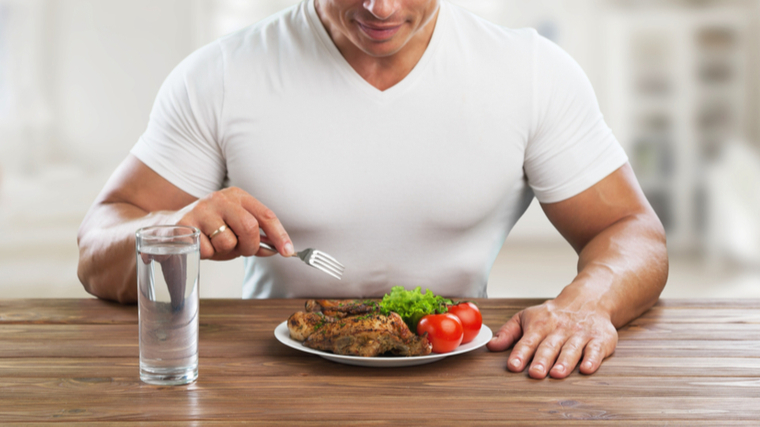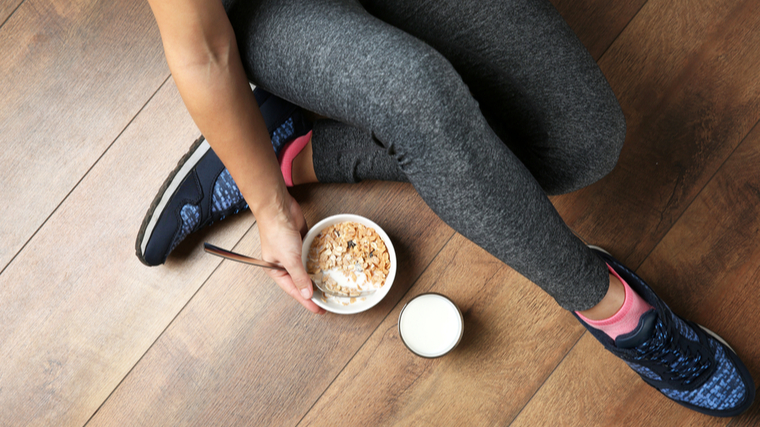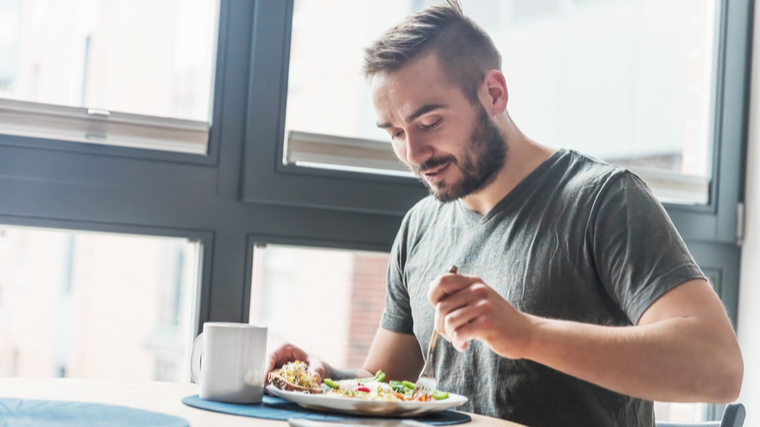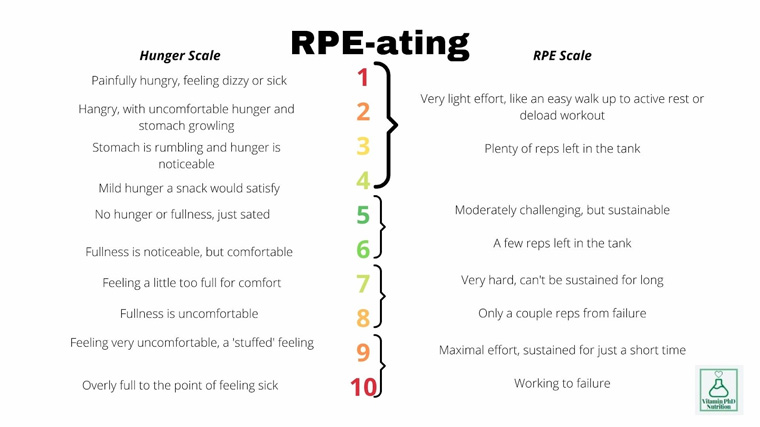The topic of intuitive eating comes up frequently in fitness content and comment sections, where it’s often debated and sometimes misunderstood. Some criticize it as an excuse to eat junk food, while others feel passionately that it represents a return to a supposedly normal way of eating after years of chronic dieting.
As usual, the most extreme ideologies aren’t entirely accurate, and once you understand what intuitive eating is — as well as what it isn’t — you can make a more informed decision about whether it might be right for you.

Regardless of your experience level, whether you’re a gym newbie or a seasoned veteran, you should have a grasp on your dietary habits and know for sure whether you should track your intake or not. This guide will help light the way.
What Is Intuitive Eating?
First, let’s get clear on some definitions. Intuitive Eating: The Revolutionary Program That Works is the title of a book that was written by registered dietitians Evelyn Tribole and Elyse Resch back in 1995. They define intuitive eating as, “…a self-care eating framework, which integrates instinct, emotion, and rational thought…”. (1)
In the simplest terms, intuitive eating refers to letting your body’s natural signals and impulses guide your eating habits instead of relying on an external structure or system like a guided diet or meal plan.
A Formal Definition of Intuitive Eating
This form of intuitive eating is intended to help people break their cycle of chronic or yo-yo dieting by relying more on internal cues (like hunger and fullness) rather than external cues (like a specific time of day or set of macros) to influence their eating and physical activity habits.
It involves a process consisting of ten principles, practices, or phases, which may or may not occur in this order:
- Reject the Diet Mentality
- Honor Your Hunger
- Make Peace with Food
- Challenge the Food Police
- Respect Your Fullness
- Discover the Satisfaction Factor
- Honor Your Feelings Without Using Food
- Respect Your Body
- Exercise — Feel the Difference
- Honor Your Health with Gentle Nutrition
Intuitive eating is an anti-diet, weight-inclusive process. This means that intuitive eating isn’t necessarily intended (or appropriate) for intentional weight change, and part of the process includes actively rejecting the diet mentality (which includes a focus on weight loss and the moralization of food, among other beliefs). (1)
It’s Not as Simple as “Not Tracking”
When someone says they’re eating intuitively, on the other hand, they may not be referring to this form of intuitive eating, but a modified version that integrates some principles — like honoring hunger, respecting fullness, and honoring feelings without using food — without actively rejecting the diet mindset or adopting a weight inclusive practice. (2)
[Read More: The Best Ab Exercises & Workouts, According to a CPT]
A person may not track macros, but if they’re tracking their bodyweight, they aren’t technically practicing the form of intuitive eating outlined in the book or discussed in this article.
What Are the Potential Benefits of Intuitive Eating?
Rates of disordered eating are higher in athletes compared to the general population, and athletes competing in weight class or physique sports are especially susceptible to risky weight loss behaviors.
Consider the common practice of macro-tracking, for example: though it isn’t proven to cause disordered eating, it is associated with higher levels of concern about eating, inflexible eating patterns, rigid dietary restraint, psychological impairment, and disordered eating behaviors, especially in people who are using it as a tool for weight loss and are already at risk of the disorder. (3)(4)(5)(6)(7)
Benefits of Weight-Neutral Approaches
Compared to weight-focused practices, intuitive eating and similar weight-neutral approaches are positively associated with a number of mental and physical health benefits. (8)(9)(10)(11)(12)
These include:
- Improved self-esteem and self-efficacy
- Higher subjective well-being
- Improved body image and body appreciation
- Bodyweight stability
- Lower use of disordered eating practices
- Lower odds of binge eating
- Less body dissatisfaction
Contrary to popular belief, intuitive eating isn’t synonymous with eating based solely on emotion, taste, or cravings, and it isn’t associated with reductions in dietary quality; in fact, some studies show that intuitive eating can lead to improvements in fruit and vegetable intake. (12)
Meeting Your Needs
Intuitive eaters practice awareness of bodily cues such as hunger, fullness, digestive discomfort, and emotions which allows them to better identify and meet their needs. They are less likely to eat simply because food is available, or to feel out of control around “off-limits” foods (because no food is off-limits.)
This way of eating can reduce the risk of disordered eating behaviors, in part, because it counters the strict, all-or-nothing mentality of strict food rules associated with rigid dietary restraint and shifts focus away from controlling body weight.(5)(11)
What Are the Potential Drawbacks of Intuitive Eating?
Intuitive eating is both a practice and a process that requires attention, patience, and openness to the experience. Unlike macro-tracking, which is like using GPS to reach a destination, intuitive eating is more like using a map and your own sense of direction to navigate.
Distracted or “Mindless” Eating
After months or years of macro-based eating, many athletes may have gotten into the habit of cleaning their plate regardless of hunger or fullness levels. Distracted or mindless eating can also steal the attention required to determine when to stop eating. Intuitive eating requires attention to the meal itself in order to respond to the feeling of satisfaction and end the meal based on internal rather than external cues. (1)
Feeling Out of Control
The process of becoming an intuitive eater also includes an exploratory phase, when an athlete begins to eat the foods that were previously off-limits but are suddenly available and novel. This can sometimes lead them to eat past the point of fullness, especially if they’re experiencing some guilt about breaking this “food rule.” (1)

There is evidence that, with repeated exposures, these foods lose their appeal and no longer lead to this situation (termed counterregulatory eating.) (13) This process can take an unknown amount of time and may lead to changes in an athlete’s body which may require additional body image flexibility work with a health professional.
Body image and stress
Some athletes feel a sense of identity tied to their way of eating or their physique, so the idea of letting go — of macro-tracking, a specific body size, or a certain diet — can be stressful. Also, there are a number of factors that can affect athletes’ perceptions of hunger, fullness, and appetite, such as intense training and psychological stress. (14)(15)
Timing
It’s also important to remember that this approach isn’t appropriate for athletes actively dieting for weight loss or eating for weight gain. These goals require ignoring hunger and fullness (at least to some extent) while often relying on external cues to eat, which makes them incompatible with intuitive eating. (2) So, timing might need to be considered to allow for weight fluctuations.
Who Should Try Intuitive Eating
While intuitive eating does seem like an attractive, anti-diet holistic approach to food, it may not be appropriate for your goals in the gym or even at home. Whether you’re a powerlifter or a physique athlete, you need to be sure that any dietary practice you partake in is relevant to your needs.
Beginners
If you’re brand new to physical training, your workout routine might already occupy a good deal of mental real estate in your mind. You don’t need to bog yourself down with even more minutiae to track and monitor. While you’re still getting acclimated to the gym, intuitive eating might be an effective hands-off approach to your nutrition in the early months.
Strength Athletes
Athletes who compete in the strength sports often need to adhere to a certain weight class at least part of the time. However, if you’ve got many months until your next competition, you may be able to loosen the reins somewhat on your diet. Intuitive eating during your off-season can be a valuable way to relax mentally and find enjoyment in low-stakes dietary practices for a while.
Off-Season Bodybuilders
A bodybuilder’s off season is all about putting on size and recovering from the harsh restriction of contest prep. It’s the perfect time to let go of your fit journal or macro tracker and learn to enjoy food again. Don’t worry, your abs won’t vanish overnight if you don’t meticulously curate every bite of food that goes into your mouth.
How to Start Eating Intuitively as a Strength Athlete
Though the process of becoming a more intuitive eater can be challenging, athletes possess some of the most important foundational skills and practice them regularly, often without realizing it. Identifying internal cues requires interoceptive awareness, or the knowledge of what type of signal the body is sending. (1)
Try Autoregulated Eating
Athletes use this form of biofeedback during training sessions when rating their level of perceived exertion (or RPE) or to adjust their stance for a more powerful squat. Athletes will also use other forms of feedback such as soreness or fatigue to adjust their planned exercise volume for a given training period to prevent injury or overtraining.
Far from being based solely on emotion, the practice of adjusting training based on emerging information — or autoregulation — is a widely used, evidence-method for individualized training progression.
Athletes engaged in weight class or physique sports may wish to start with a modified version of intuitive eating, or internally-regulated eating, which mimics autoregulation. They could start with the practice of hunger training, which involves eating in response to the initial signs of hunger: an empty, hollow feeling in the stomach with grumbling (and perhaps some fatigue). (16)
From there, they could use a modified RPE scale applied to hunger in order to reach a level of comfortable fullness, regardless of the amount of food left on the plate. They could also replace a macro-based meal with one that uses plate-planning. Athletes engaging in intense training might need to rely more heavily on plate-planning during times that their appetites or hunger might be blunted by intense training.
Keep a Journal
In the same way that a training journal is a useful tool for tracking the effects of a training plan and making adjustments, a food and feelings journal is an important tool for this purpose. Rather than recording macros, a food and feelings journal is used to record physical and emotional feelings before and after the meal in order to make adjustments in future meals.
Other biofeedback — such as recovery and energy levels — can also provide insight about an athlete’s general energy balance and guide food intake.
Focus on the Process, Not Perfection
Intuitive eating isn’t a standardized, one-size-fits-all approach, and everyone’s experience will be unique. After years of structured dieting, it may be tempting to set more rules — like only eating in the presence of hunger, and never eating past fullness — in an attempt to be a “perfect” intuitive eater. Strict rules like this can still be forms of rigid restraint, however, which undermine one’s ability to integrate biofeedback and experience in a rational way. (4)
If quitting macros cold-turkey feels overwhelming, take this step-by-step as well. Try aiming for macro ranges, only tracking a certain macro, or only tracking certain meals at first. Once this feels more comfortable, continue to make changes to become progressively less reliant on macros, like taking entire days off.

Remember that the purpose of this process isn’t to hit macro targets without tracking them; it’s about establishing a whole new way of approaching meals.
Summary
Contrary to the ways it might be depicted on social media, intuitive eating isn’t as simple eating only when hungry or as disorganized as eating without any thought at all. It’s a gradual process of integrating internal cues, experience, and thought to guide your eating and physical activity habits.
As a weight-inclusive, anti-diet framework, it isn’t a tool for weight modification; instead it’s a way to break the cycle of chronic dieting and compulsive macro-tracking while improving your body image and well-being. If you’re sick of micromanaging your approach to fitness, give your intuition a chance to manage your eating habits.
References
1. Tribole, E., & Resch, E. (2012). Intuitive eating. New York: St. Martin’s Griffin.
2. Helms, E. R., Prnjak, K., & Linardon, J. (2019). Towards a sustainable nutrition paradigm in physique sport: A narrative review. Sports, 7(7), 1–19.
3. Buckley, G. L., Hall, L. E., Lassemillante, A. C. M., Ackerman, K. E., & Belski, R. (2019). Retired athletes and the intersection of food and body: A systematic literature review exploring compensatory behaviours and body change. Nutrients, 11(6).
4. Schaumberg, K., Anderson, D. A., Anderson, L. M., Reilly, E. E., & Gorrell, S. (2016). Dietary restraint: what’s the harm? A review of the relationship between dietary restraint, weight trajectory and the development of eating pathology. Clinical Obesity, 6(2), 89–100.
5. Simpson, C. C., & Mazzeo, S. E. (2017). Calorie counting and fitness tracking technology: Associations with eating disorder symptomatology. Eating Behaviors, 26, 89–92.
6. Linardon, J., & Messer, M. (2019). My fitness pal usage in men: Associations with eating disorder symptoms and psychosocial impairment. Eating Behaviors, 33(September 2018), 13–17.
7. Hazzard, V. M., Telke, S. E., Simone, M., Anderson, L. M., Larson, N. I., & Neumark-Sztainer, D. (2020). Intuitive eating longitudinally predicts better psychological health and lower use of disordered eating behaviors: Findings from EAT 2010-2018 (in press). Eating and Weight Disorders.
8. Van Dyke, N., & Drinkwater, E. J. (2014). Review Article Relationships between intuitive eating and health indicators: Literature review. Public Health Nutrition, 17(8), 1757–1766.
9. Ogden, J., Pavlova, E., Fouracre, H., & Lammyman, F. (2020). The impact of intuitive eating v. pinned eating on behavioural markers: A preliminary investigation. Journal of Nutritional Science, 9, 1–6.
10. Linardon, J., & Mitchell, S. (2017). Rigid dietary control, flexible dietary control, and intuitive eating: Evidence for their differential relationship to disordered eating and body image concerns. Eating Behaviors, 26, 16–22.
11. Mensinger, J. L., Calogero, R. M., Stranges, S., & Tylka, T. L. (2016). A weight-neutral versus weight-loss approach for health promotion in women with high BMI: A randomized-controlled trial. In Appetite (Vol. 105). Elsevier Ltd.
12. Plateau, C. R., Petrie, T. A., & Papathomas, A. (2017). Learning to eat again: Intuitive eating practices among retired female collegiate athletes. Eating Disorders, 25(1), 92–98.
13. Epstein, L. H., Temple, J. L., Roemmich, J. N., & Bouton, M. E. (2009). Habituation as a determinant of human food intake. Psychological review, 116(2), 384–407.
14. Beaulieu, K., Hopkins, M., Blundell, J., & Finlayson, G. (2018). Homeostatic and non-homeostatic appetite control along the spectrum of physical activity levels: An updated perspective. Physiology and Behavior, 192, 23–29.
15. Oshima, S., Takehata, C., Sasahara, I., Lee, E., Akama, T., & Taguchi, M. (2017). Changes in stress and appetite responses in male power-trained athletes during intensive training camp. Nutrients, 9(8), 1–13.
16. Ciampolini, M., David Lovell-Smith, H., Kenealy, T., & Bianchi, R. (2013). Hunger can be taught: Hunger Recognition regulates eating and improves energy balance. International Journal of General Medicine, 6, 465–478.
Featured Image: Billion Photos / Shutterstock

